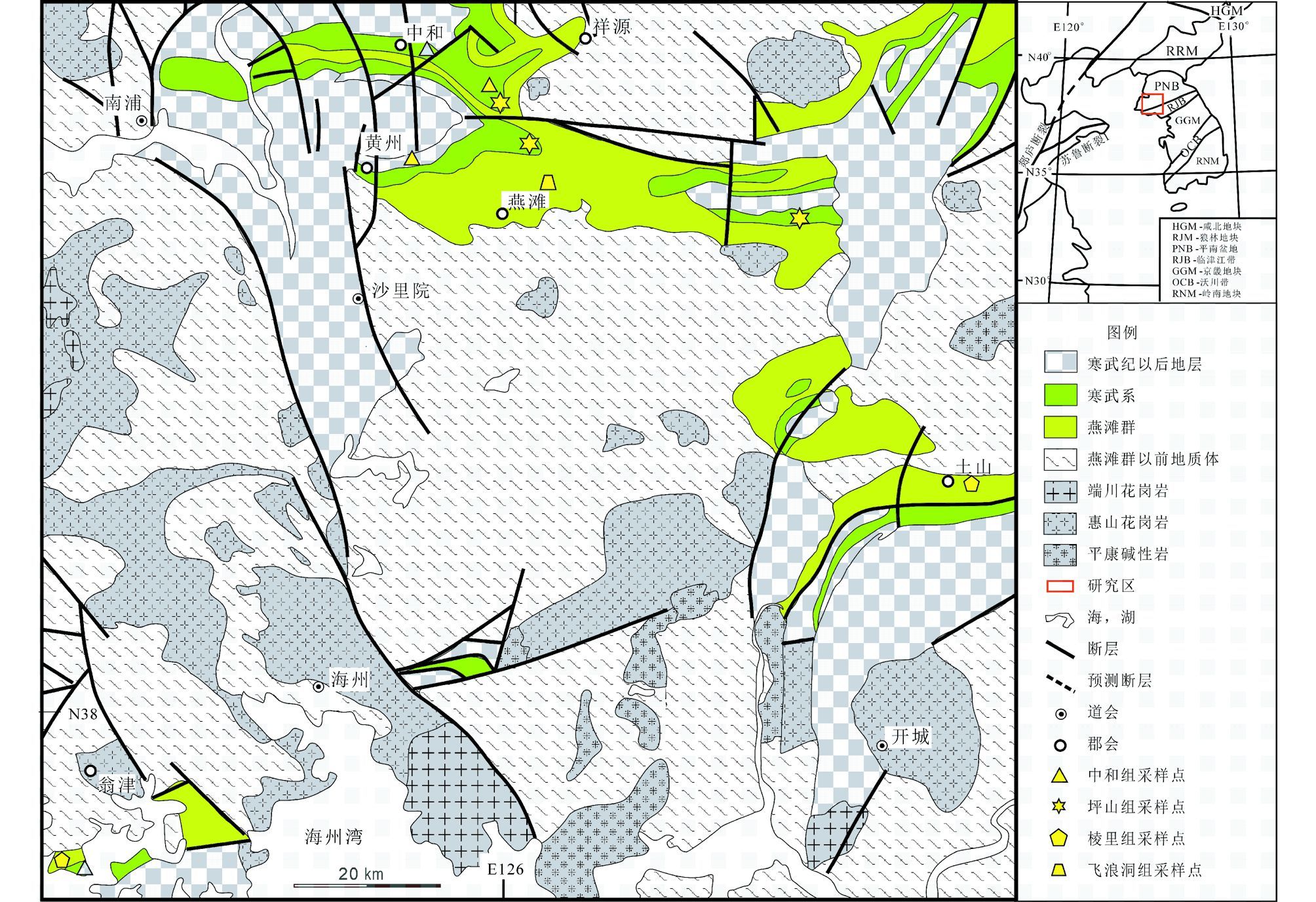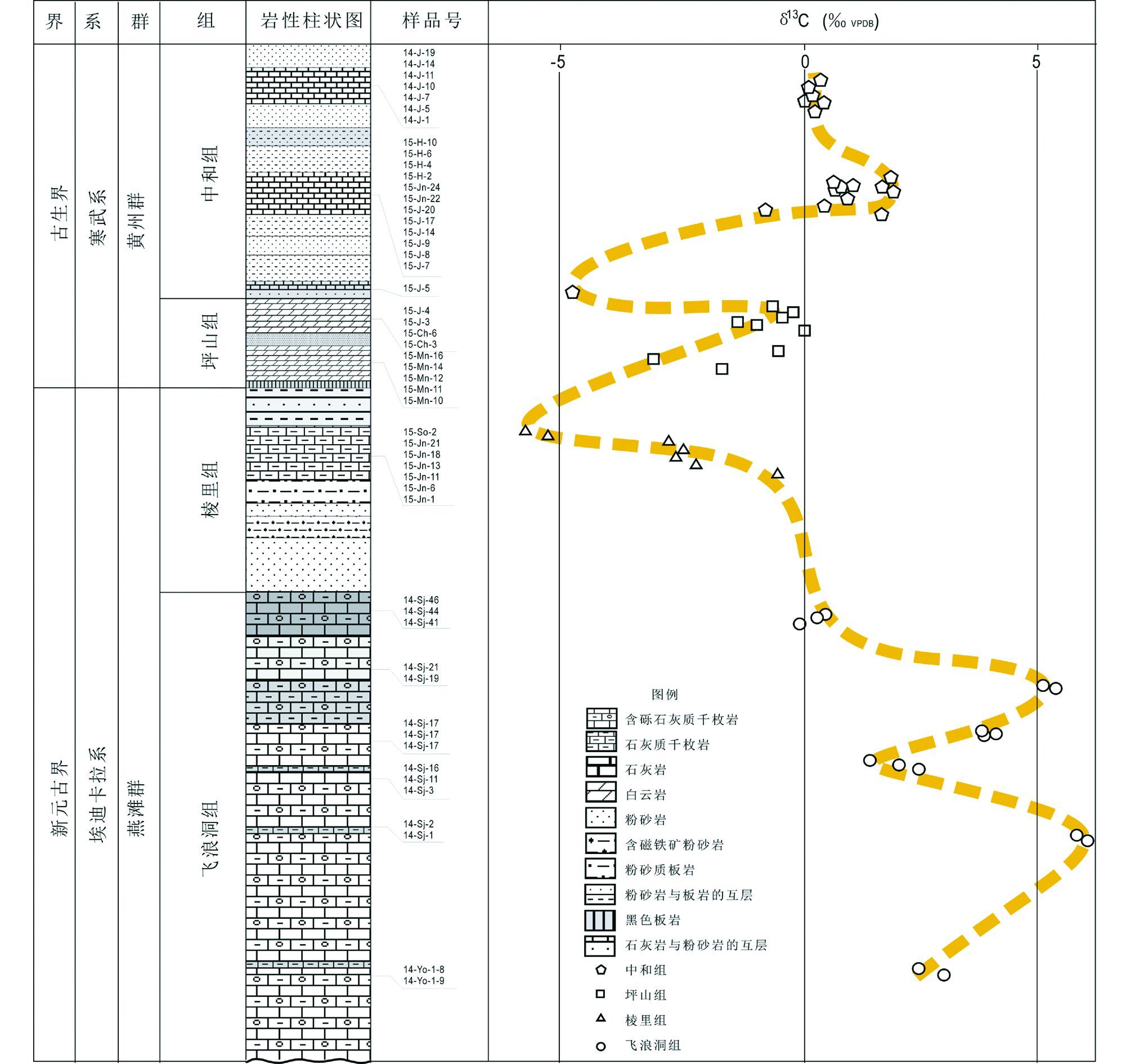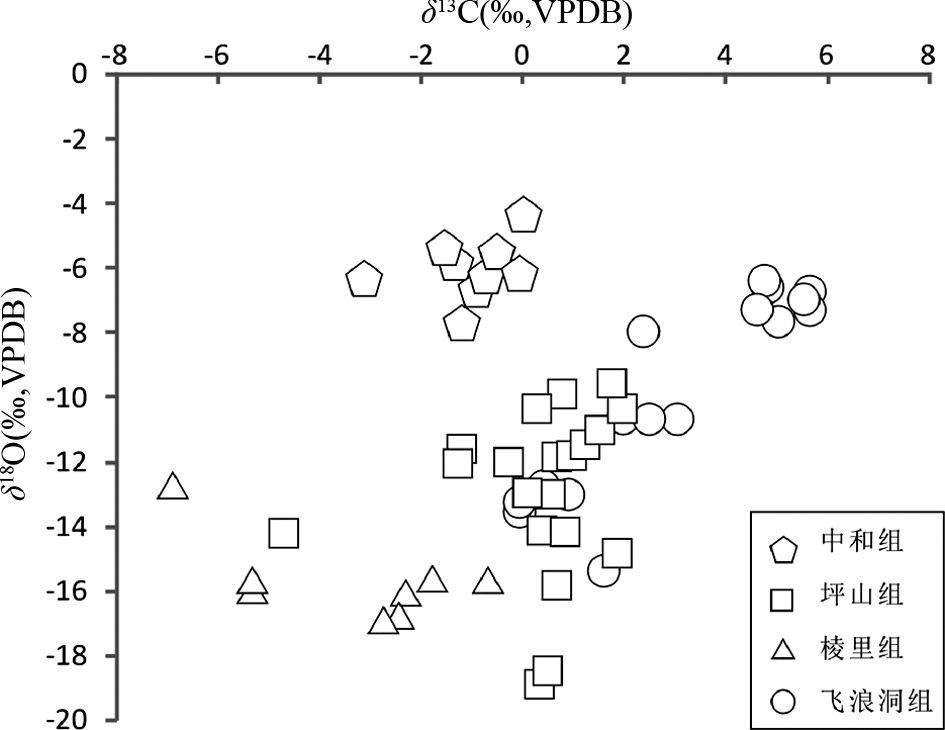2. 中国科学院地质与地球物理研究所, 岩石圈演化国家重点实验室, 北京 100029
2. State Key Laboratory of Lithospheric Evolution, Institute of Geology and Geophysics, Chinese Academy of Sciences, Beijing 100029, China
朝鲜半岛平南盆地是中朝古陆(华北古陆)新元古界与古生界地层广泛发育的地区之一(图 1)。一般认为,平南盆地相关地层可以与邻区华北境内新元古界-古生界地层进行对比(Choi and Kim,1997; Park et al.,2001,2016; Kim,2010; Kwon,2005; Hu et al.,2012)。Peng et al.(2011) 及朴贤旭等(2016) 认为平南盆地可以与辽东大连(旅大)盆地和徐淮盆地对比,甚至可能曾经属于同一裂谷。最近的微古化石研究表明,该地区的燕滩群地层可能属于埃迪卡拉系,并有人提出部分地层可能为冰碛岩;而根据三叶虫等化石特点,其上的黄州(超)群属于下寒武统(Ri et al.,2002; Park and So,2008; Pak and So,2010; Pak and Ri,2003; Jang and Pae,2004,2007; Jang,2001; Jang and Pak,2000)。如果得到证实,将为我们认识埃迪卡拉系-下寒武统地层和表生环境变化提供难得的剖面。相关地层尚未开展过化学地层研究,本文将对埃迪卡拉系-下寒武统的燕滩群-黄州群开展碳、氧同位素研究,通过与国际地层表化学地层特征对比,厘定相关地层的时代,并且探讨埃迪卡拉系-下寒武统界线附近碳同位素变化。

|
图 1 平南盆地南部地质简图(据Paek et al.,1996改编) Fig. 1 Simplified geological map of the southern Pyongnam Basin(revised from Paek et al.,1996) |
平南盆地埃迪卡拉系与下寒武统地层分布如图 1。埃迪卡拉系地层最初被称为岣仙系(狗岘系/狗岘群),2006年新编的朝鲜地层表改称为燕滩群,是祥原系(超群)中最上部的地层,与下伏灭恶山群角度不整合(Park,2006)。燕滩群从下往上由飞浪洞组和棱里组组成,厚度变化较大,从不超过100m(Hoechang桧仓郡)到近2000m不等(法洞郡)(Park,2012)。燕滩群飞浪洞组主要由含砾灰质千枚岩与灰质千枚岩互层组成,往上灰质逐渐变少;棱里组渐变为以泥质千枚岩为主。飞浪洞组多发育碳酸盐夹层,燕滩地区飞浪洞组含有由灰岩与白云岩多层碳酸盐地层。翁津地区棱里组也夹有碳酸盐夹层。这些碳酸盐岩夹层是碳同位素分析的理想样品。
下寒武世地层黄州超群从下而上为坪山组和中和组,厚度变化从100余米到500米(Park,2012)。坪山组由黑色板岩、暗灰色含磷粉砂质板岩、含磷粉砂岩、暗灰色白云岩,灰岩组成,部分地区含有石煤与砂岩夹层。其中,黑色板岩与磷及金属硫化物和部分火山岩密切相关,这是坪山组的突出特征(Park et al.,2004; Choi and Jong,2010)。中和组由砂岩、粉砂岩、灰岩、板岩等组成;底部砂岩的分布很广,延续性好,并且含有三叶虫层型化石。其中,底部灰质砂岩是用来区分坪山组和中和组的标志层(Kwon et al.,2010; Park,2012)。
3 样品描述根据采样剖面,做出了图 2剖面图,剖面地层总厚度约1000m,本研究共采集样品56件(图 1、图 2、表 1)。17件样品来自飞浪洞组,均采自燕滩地区,包括白云岩样品11件,灰岩样品1件,泥质灰岩样品2件,灰质千枚岩样品3件。这些岩石都以夹层的形式分布于飞浪洞组不同层位中。
|
|
表 1 平南盆地燕滩群和黄州群碳酸盐样品碳、氧同位素数据表 Table 1 Carbon and oxygen isotope compositions of carbonates from the Yontan and Hwangju groups in the Pyongnam basin |

|
图 2 平南盆地南部燕滩群-黄州群地层柱状图及碳酸盐岩δ13C值变化图(地层等厚图据Paek et al.,1996修改) Fig. 2 Strata column and variation of δ13C values of carbonate samples of the Yontan-Hwangju Groups in the Pyongnam basin(the isothickness lithostratigraphic column is revised from Paek et al.,1996) |
8件样品来自棱里组,采样层位见图 2,其中7件灰质千枚岩来自翁津地区,1件灰质白云岩来自土山地区。翁津地区采样点灰质千枚岩厚20余米,整合于粉砂岩与粉砂质板岩之上,样品为等距采集。土山地区采样点灰质白云岩整合于飞浪洞组砾岩之上的两层砂岩之间。
9件样品来自坪山组,采样层位见图 2,其中祥源地区白云岩样品2件,燕滩地区白云岩和灰质白云岩分别采样5件和2件。祥源地区坪山组由整合于棱里组千枚岩之上的黑色结核状磷灰岩、暗绿色重晶石凝灰岩、细碧岩、凝灰岩等与整合于其上的灰色白云岩组成,本次采集的样品为灰色白云岩。燕滩地区白云岩样品来自整合于棱里组板岩之上的坪山组黑色碳质板岩上的暗灰色块状白云岩,以及白云岩地层上部砂岩之上的灰质白云岩。
22件样品采自中和组,采样层位见图 2,包括中和地区灰岩8件,黄州地区灰岩4件,翁津地区灰岩2件和祥源地区灰岩8件。黄州地区灰岩样品来自坪山组灰绿色灰岩,其上是粉砂岩与板岩;翁津地区灰岩样品来自整合于棱里组之上的含磷灰土粉砂岩的粉砂岩之上的灰岩;祥源地区灰岩样品来自坪山组白云岩之上的灰岩。
4 分析方法所采的碳酸盐岩样品可能受到了后期蚀变作用影响。为了获取原始沉积的碳、氧同位素信息,在采样过程中尽量选择结晶度很低,无岩脉侵入,无后期方解石与石英细脉的样品。根据显微镜下观察选择比较新鲜的样品进行分析。碳酸盐岩样品为白云岩、灰岩、灰质千枚岩、灰质白云岩等。所有样品研磨至200目以下,采用无水正磷酸法,制备供质谱分析的CO2气体。白云岩和灰岩的反应温度为25℃,反应时间分别为恒温72h和24h。CO2的C、O同位素分析是在中国科学院地质与地球物理研究所稳定同位素实验室MAT-253质谱仪上完成的。C、O同位素组成分别以δ13C和δ18O表示,并且均相对于VPDB(Vienna PeeDee Belemnite)国际标准。δ13C和δ18O的标准偏差分别优于0.15‰和0.20‰。相关数据见表 1。
5 分析结果图 3是所有样品的δ18O与δ13C相关图,可以看出,黄州群样品没有相关性,说明这些样品很可能记录了沉积特征;燕滩群飞狼洞组样品有正相关性特点,但样品整体偏正,不同于后期改造特点,有可能记录沉积特征;棱里组显示弱的负相关性,说明负值较大的样品很可能记录了原始的碳同位素组成。

|
图 3 平南盆地燕滩群和黄州群样品δ18O与δ13C相关图 Fig. 3 Correlation diagram of δ18O and δ13C of carbonates of the Yontan and Hwangju groups in the Pyongnam basin |
图 2标示各层位样品δ13C变化。其中,飞浪洞组从下到上,δ13C值从+2‰逐渐变大到+6‰后,再逐渐变小到+2‰,又变大到+6‰;棱里组从下到上,δ13C值从0开始变小,一直到-7‰;坪山组除了下部层位有一个-3.1‰的δ13C值外,大都在-1.5‰~0‰之间变化;中和组除了下部层位的一个-4.7‰外,所有值在-1.2‰~+1.9‰范围变化,负值大部分在下部层位,正值在中部层位,接近0‰的值分布于上部层位。总的来看,从飞浪洞组到中和组,碳同位素值从下部的较大正值开始逐渐变小,在埃迪卡拉系与寒武系地层之间界线附近的棱里组和坪山组都为负值,到了中和组上部层为+2‰。从平均值角度看,飞浪洞组的δ13C值从-0.1‰到+5.6‰之间变化,平均值为3.0‰,4个组中最大;棱里组δ13C值为-6.9‰~-0.7‰,平均值为-3.4‰,4个组中最小;坪山组δ13C值为-3.1‰~0‰,平均值-1.0‰;中和组δ13C值为-4.7‰~+2‰,平均值为+0.4‰。总的来看,燕滩群最上部地层碳同位素值为-6.9‰~-0.7‰,平均值-3.4‰,向顶部变负;黄州群最下部地层碳同位素值-3.1‰~0‰,平均值-1.0‰,向底部负值变小;燕滩群下部最大值为+6‰,黄州群上部变化范围为0~+2‰。
6 讨论前人根据燕滩群飞浪洞组的微古化石研究,提出该套地层属于埃迪卡拉系晚期,且部分地层可能为冰碛岩(Ri et al.,2002; Park and So,2008; Pak and So,2010; Pak and Ri,2003; Jang and Pae,2004,2007; Jang,2001; Jang and Pak,2000);然而,飞浪洞组碳同位素值中却没有检测到类似Gaskiers冰期对应的负值,这可能说明飞浪洞组并不是对应于Gaskiers冰期的沉积序列,与前人提出可能为冰碛岩的结论不一致。δ13C负值主要出现在棱里组岩石中,如翁津地区灰质千枚岩的δ13C值从下部往上从-0.7‰之间变到-6.9‰,平均值为-3.4‰。
考虑到棱里组与上覆的寒武系坪山组为连续沉积,我们认为,棱里组的碳同位素的负漂移可能与Gaskiers或Marinoan等冰期不可对比,而应该对应于埃迪卡拉系最末期的负漂移(Maloof et al.,2010; MacDonald et al.,2013)。而岩滩群碳同位素+5.6‰到-6.9‰变化特征与世界其它地区如Oman和Moroco等地相似;也与我国华南地区埃迪卡拉末系灯影组的碳同位素特征相似,其沉积年龄可能介于551~543Ma之间(Fike et al.,2006; Maloof et al.,2010; Condon et al.,2005)。飞浪洞组-中和组的碳同位素值得变化趋势可以很好地与世界各地埃迪卡拉系末期-下寒武统地层的变化趋势进行对比(图 4; Condon et al.,2005; Fike et al.,2006; Halverson et al.,2010; Maloof et al.,2010; Cox et al.,2016),也与国际地层年表中同时期碳同位素值变化趋势一致(Ogg et al.,2008)。鉴于该地层为连续剖面,不存在不整合,因此,该地层很可能是从埃迪卡拉系末期到寒武系早期的连续剖面。

|
图 4 平南盆地燕滩群和黄州群碳同位素值与世界同期地层碳同位素值得对比图 底图数据引自Cox et al.(2016) 和Halverson et al.(2010) . 其中,祥原超群数据及默川期异常据朴贤旭等(2016) Fig. 4 A comparison of carbon isotope of the Yontan and Hwangju groups in the Pyongnam basin and the contemporaneous global trend Data of base map cited from Cox et al.(2016) and Halverson et al.(2010) . Data of the Sangwon Supergroup and the Muckchon anomaly are from Park et al.(2016) |
我们认为,平南盆地燕滩群-黄州群可以作为埃迪卡拉系末期-寒武系早期代表性地层。平南盆地南部坪山组底部的黑色板岩具有含磷、含金属硫化物的含矿特征,前人将其作为该组的标志(Kwon et al.,2010; Sim,1991),从碳同位素特征来看,负漂移确实发生在这个层位附近,这说明这一界线可能与全球埃迪卡拉系和寒武系界线是对应的。这一标志层同样见于徐淮盆地下寒武统底部猴家山组(安徽省地质局区域地质调查队,1988)。对比徐淮盆地碳同位素数据(Xiao et al.,2014),徐淮地区栏杆群或可与燕滩群对比,然而,这一对比还需要进一步的地层层序和古生物学等方面的证据。与大连盆地地层的对比有待进一步的数据支持。
7 结论本文获得了朝鲜平南盆地燕滩群(飞狼洞组和棱里组)和黄州(超)群(坪山组和中和组)地层碳、氧同位素变化趋势。通过对比分析,我们得到如下结论:
(1) 各层位δ13C值可以反映岩石沉积特征:飞浪洞组从底部+2‰开始,在+2‰和+6‰之间变化,最上部为+2‰;棱里组从下到上从0降至-7‰;坪山组在-3.1‰~0‰之间变化;中和组基本上在-1.2‰~+1.9‰之间变化。
(2) 飞浪洞组碳同位素值中却没有测试到类似Gaskiers冰期对应的负值;棱里组的δ13C值从-0.7‰之间变到-6.9‰,该地层与Gaskiers或Marinoan等冰期不可对比,其负漂移可能对应埃迪卡拉系最末期的负漂移。
(3) 燕滩群-黄州群地层碳同位素值变化趋势与国际地层年表中埃迪卡拉系末期-寒武系早期界线附近碳同位素变化一致,由于该地层为连续地层,因此可以作为埃迪卡拉系-下寒武统连续剖面,黄州群坪山组底部含磷、含金属硫化物黑色板岩可以作为标志层。
致谢 本文是中朝两国科学院地质学研究团队集体成果。感谢李忠研究员、郭庆军研究员等对初稿的修改意见。| [1] | Choi DH and Kim HG. 1997. Stratigraphy and lithofacies-paleogeographyic properties of lower bed of Hwangju System, Hyonnae Area. Geoprosecting , 4 :11–12. |
| [2] | Choi DH and Jong HI. 2010. Lithofacies-paleogeography of lower bed of Hwangju Group. Geological and Geographical Science , 2 :29–30. |
| [3] | Condon D, Zhu MY, Bowring SA, Wang W, Yang AH and Jin YG. 2005. From the Marinoan glacia-tion to the oldest bilaterians:U-Pb ages from the Neoproterozoic Doushantuo Formation, China. Science , 308 (5718) :95–98. DOI:10.1126/science.1107765 |
| [4] | Cox GM, Halverson GP, Stevenson RK, Vokaty M, Poirier A, Kunzmann M, Li ZX, Denyszyn SW, Strauss JV and Macdonald FA. 2016. Continental flood basalt weathering as a trigger for Neoproterozoic Snowball Earth. Earth and Planetary Science Letters , 446 :89–99. DOI:10.1016/j.epsl.2016.04.016 |
| [5] | Fike DA, Grotzinger JP, Pratt LM and Summons RE. 2006. Oxidation of the Ediacaran Ocean. Nature , 44 :744–747. |
| [6] | Geological Investigation Group of the Geological Bureau of the Anhui Province.1988. Strata of Anhui-Cambrian. Hefei: Science and Technology Publishing House of Anhui : 1 -198. |
| [7] | Halverson GP, Wade BP, Hurtgen MP and Barovich KM. 2010. Neoproterozoic chemostratigraphy. Precambrian Research , 182 (4) :337–350. DOI:10.1016/j.precamres.2010.04.007 |
| [8] | Hu B, Zhai MG, Li TS, Li Z, Peng P, Guo JH and Kusky TM. 2012. Mesoproterozoic magmatic events in the eastern North China Craton and their tectonic implications:Geochronological evidence from detrital zircons in the Shandong Peninsula and North Korea. Gondwana Research , 22 (3-4) :828–842. DOI:10.1016/j.gr.2012.03.005 |
| [9] | Jang TS and Pak YC. 2000. Vendian (V) fossil of animal and plant found from Hwangju and Yonthan regions. Bulletin of Kim Il Sung University , 46 (6) :100–103. |
| [10] | Jang TS. 2001. On some new fossil animals discovered at the Kuhyon series and their geological significance. Geological Science , 4 :8–10. |
| [11] | Jang TS and Pae PH. 2004. Studies on the new paleontological fossils of Kuhyon system of Rungri Formation and biostratigraphy. Bulletin of Kim Il Sung University , 4 :173–176. |
| [12] | Jang TS and Pae PH, 2007. On some species of Metazoa fossils found in Rungri Formation, Yontan Group in Kwail area. Bulletin of Kim Il Sung University, 4:178-182 (in Korean with English abstract) |
| [13] | Kim CJ. 2010. Lithofacies-paleogeography during sedimentation of Vendian Period. Geological and Ore Deposit , 5 :22–26. |
| [14] | Kwon JM. 2005. Paleogeographic properties of Lower Paleozoic. Geoprospecting , 4 :7–8. |
| [15] | Kwon JR, Park MH, Won CK and Pak YH. 2010. Stratigraphy of Korea (2). Kim Il Sung University Press :13–81. |
| [16] | Macdonald FA, Strauss JV, Sperling EA, Halverson GP, Narbonne GM, Johnston DT, Kunzmann M, Schrag DP and Higgins JA. 2013. The stratigraphic relationship between the Shuram carbon isotope excursion, the oxygenation of Neoproterozoic oceans, and the first appearance of the Ediacara biota and bilaterian trace fossils in northwestern Canada. Chemical Geology , 362 :250–272. DOI:10.1016/j.chemgeo.2013.05.032 |
| [17] | Maloof AC, Porter SM, Moore JL, Dudás FÖ, Bowring SA, Higgins JA, Fike DA and Eddy MP. 2010. The earliest Cambrian record of animals and ocean geochemical change. Geological Society of America Bulletin , 122 (11-12) :1731–1774. DOI:10.1130/B30346.1 |
| [18] | Ogg JG, Ogg G and Gradstein FM.2008. The Concise Geologic Time Scale. Cambridge: Cambridge University Press : 31 -33. |
| [19] | Paek RJ, Kang HG and Jon GP.1996. Geology of Korea. Pyeongyang: Foreign Language Book Publishing House : 31 -51. |
| [20] | Pak YC and Ri HS. 2003. Some species of microfossil found from the Pirangdong Formation of Upper Proterozoic era of Pirangdong region, Kumbong-ri, Yontan County. Bulletin of Kim Il Sung University , 6 :169–172. |
| [21] | Pak YC and So KS. 2010. Some species of microplant fossils from the upper part of Upper Proterozoic strata. Bulletin of Academy of Sciences , 1 :44–45. |
| [22] | Park HS, Choi DH and Ri CM. 2004. Genetic classification of concretions and distribution properties of metal elements in lower bed of Hwangju Group. Geological and Geographical Science , 3 :25–27. |
| [23] | Park HU, Zhai MG, Yang JH, Peng P, Kim JN, Zhang YB, Kim MC, Park U and Feng LJ. 2016. Deposition age of the Sangwon Supergroup in the Pyongnam basin (Korea) and the Early Tonian negative carbon isotope interval. Acta Petrologica Sinica , 32 (7) :2181–2195. |
| [24] | Park MH, Ri SB and Kim CG. 2001. Litho-paleogeography in the period of deposition of Solhwasan System Muckchon series in Upper Proterozoic era. Bulletin of Kim Il Sung University , 9 :160–163. |
| [25] | Park MH. 2006. Principle of stratum division and stratigraphic chart of Korea. Bulletin of Geological Society of Korea , 1 :2–9. |
| [26] | Park MH. 2012. Geological series of Korea (2). Industrial Publishing House, 309-363 (in Korean) |
| [27] | Park MH, So GS and Kim PS. 2016. On the Boundary of the Meso- and Neoproterozoic Erathem by the stromatolite fossil and Tussocky microstructure (1). Geological and Geographical Science , 261 (1) :7–9. |
| [28] | Park YC and So GS. 2008. Some species of microfossils found in Upper Rungri Formation, Yontan Group of Upper Proterozoicc in Subong-ri, Yontan County, Geological Science, 4:42-43 (in Korean with English abstract) |
| [29] | Peng P, Zhai MG, Li QL, Wu FY, Hou QL, Li Z, Li TS and Zhang YB. 2011. Neoproterozoic (~900Ma) Sariwon sills in North Korea:Geochronology, geochemistry and implications for the evolution of the south-eastern margin of the North China Craton. Gondwana Research , 20 (1) :243–254. DOI:10.1016/j.gr.2010.12.011 |
| [30] | Ri HS, Park YC and So GS. 2002. On Some microfossils (Algae) found the Rungri Formation, Upper Proterozoic era of the Hukyo-ri region, Hwangju County. Bulletin of Kim Il Sung University , 8 :137–139. |
| [31] | Sim HC. 1991. The relationship between the Rungri Formation of Kuhyon System and the lower bed of Junghwa Formation. Geological and Geographical Sciences , 6 :45–46. |
| [32] | Xiao SH, Shen B, Tang Q, Kaufman AJ, Yuan XL, Li JH and Qian MP. 2014. Biostratigraphic and chemostratigraphic constraints on the age of Early Neoproterozoic carbonate successions in North China. Precambrian Research , 246 :208–225. DOI:10.1016/j.precamres.2014.03.004 |
| [33] | 安徽省地质局区域地质调查队. 1988. 安徽地层志-寒武纪分册. 合肥: 安徽科学技术出版社 : 1 -198. |
| [34] | 朴贤旭, 翟明国, 杨正赫, 彭澎, 金正男, 张艳斌, 金明哲, 朴雄, 冯连君.2016. 朝鲜平南盆地祥原超群的沉积时代与拉伸纪早期碳同位素负漂移. 岩石学报 , 32 (7) :2181–2195. |
 2016, Vol. 32
2016, Vol. 32


